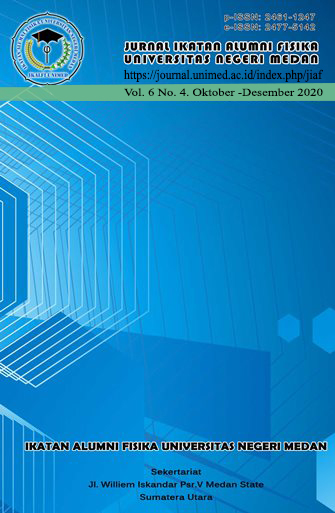Pengembangan Bahan Ajar IPA Terpadu Tipe Connected Pada Materi Zat dan Karakteristiknya
DOI:
https://doi.org/10.24114/jiaf.v6i4.20052Keywords:
Teaching Materials, Integrated Learning Type Connected, Substance, and Characteristics.Abstract
ABSTRACKThis research development was carried out to develop teaching materials in the form of Integrated Science modules connected to the type of substance and its characteristics. This teaching material is printed. The purpose of this study is to find out how to develop this teaching material and also to find out how the feasibility of this teaching material.The development procedure is based on the steps of the Four D (4D) model with minor adjustments. The stages of development are carried out in 4 stages namely, first; conduct needs analysis through literature study, second; shield and arrange teaching materialsthrough determining the subject matter and determining the relevant KD, third; productdevelopment stage using product validation by 3 material experts and 1 media expert, fourth; dissimilation that results in Integrated Science teaching materials of Connected Type in Substance Material and Characteristics.The results of the needs analysis show that the pursuit of science separately is an obstacle for students to absorb material optimally. The use of learning media such as teaching materials can be a fun learning resource for students. Also, the application of integrated learning models can facilitate students in learning the integration of science. Thus developed an integrated teaching material. In this case, using the Integrated Science Learning Type Connected. The data collection process uses a questionnaire with the appropriateness assessment instrument of teaching materials by BSNP. According to the analysis data, the assessment presentation by 3 material experts and 1 media expert was 86.53% and 90.10% respectively, indicating that this teaching material was appropriate to be used as Integrated Science teaching material on Substance Material and Characteristics.References
Anwar, S. (2014). Bahan Perkuliahan: Pengolahan Bahan Ajar. Bandung: Universitas Pendidikan Indonesia
Depdiknas, 2006, Panduan Pengembangan Pembelajaran IPA Terpadu untuk SMP/MTs, Jakarta: Pusat Kurikulum, Balitbang Depdiknas.
Ernawati. (2014). Pengembangan Perangkat Pembelajaran Berdasarkan Model 4-D Pada Materi Getaran Gelombang dan Bunyi dalam Meningkatkan Pemahaman Konsep Siswa SMP Negeri 6 Palu. Pendidikan Sains Pascasarjana, Universitas Tadulako.
Helfidayati. (2016). Peran Bahan Ajar IPA Terpadu Tipe Connected Pada Tema Pemanasan Global Terhadap Penguasaan Konsep Siswa. Universitas Pendidikan Indonesia. Jogjakarta
Lesteri, Ika. 2013. Pengembangan Bahan Ajar Berbasis Kompetensi. Padang: Akademi Permata
Listyawati, 2012. Pengembangan Perangkat Pembelajaran IPA Terpadu di SMP. Journal of Innovative Science, Universitas Negeri Senarang. Indonesia, Volume 1, Nomor 1.
Kumala. D, dkk (2013) Pengembangan Perangkat Pembelajaran IPA Terpadu dengan Setting Inkuiri Terbimbing Untuk Meningkatkan Pemahaman Konsep dan Kinerjad Ilmiah Siswa. Program Pascha Sarjana, Universitas Pendidikan Ganesha. Vol.3
Nidyasarifitri, F. Dkk. (2017). Pengembangan LKS Berbasis PBL (Problem Based Learning) Pada Pokok Bahasan Momentum dan Impuls Fisika SMA Kelas XI. Wahana Pendidikan Fisika.
Prabowo. 2000. Pembelajaran Tematikn Terpadu. Malang: Gaya Media
Pujayanto, Hardini, R., Ekawati, E. Y. (2012). Pengembangan bahan ajar IPA Terpadu Berbasis Salingtemas untuk Siswa Kelas VII Dengan Tema Ekosistem Air Tawar. Jurnal Materi dan Pembelajaran Fisika, 3(1), 9-13
Yuliati, L. (2012). Efektivitas Bahan Ajar IPA Terpadu Terhadap Kemampuan Berpikir Tingkat Tinggi Siswa SMP. Jurnal Pendidikan Fisika Indonesia, Universitas Negeri Malang.
Downloads
Published
Issue
Section
License
Copyright (c) 2021 JURNAL IKATAN ALUMNI FISIKA UNIVERSITAS NEGERI MEDAN

This work is licensed under a Creative Commons Attribution 4.0 International License.
Authors who publish with this journal agree to the following terms:- Authors retain copyright and grant the journal right of first publication with the work simultaneously licensed under a Creative Commons Attribution License that allows others to share the work with an acknowledgement of the work's authorship and initial publication in this journal.
- Authors are able to enter into separate, additional contractual arrangements for the non-exclusive distribution of the journal's published version of the work (e.g., post it to an institutional repository or publish it in a book), with an acknowledgement of its initial publication in this journal.
- Authors are permitted and encouraged to post their work online (e.g., in institutional repositories or on their website) prior to and during the submission process, as it can lead to productive exchanges, as well as earlier and greater citation of published work (See The Effect of Open Access).


 Jl. Williem Iskandar Psr. V, Medan Estate, Kec. Percut Sei Tuan, Kabupaten Deli Serdang, Sumatera Utara 20221
Jl. Williem Iskandar Psr. V, Medan Estate, Kec. Percut Sei Tuan, Kabupaten Deli Serdang, Sumatera Utara 20221